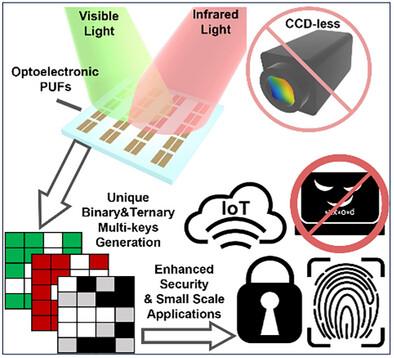基于量子点和钙钛矿的光电转换二进制和三元密钥的物理不可克隆函数
IF 19
1区 材料科学
Q1 CHEMISTRY, MULTIDISCIPLINARY
引用次数: 0
摘要
物理不可克隆功能(puf)是基于硬件的安全密钥,被认为是智能系统最有前途的下一代安全解决方案之一。许多研究报告了光学和电气puf;然而,这些puf表现出一定的局限性,如复杂的读出系统和低编码容量。在本研究中提出了能够使用依赖于入射光波长的电信号产生加密多密钥的光电puf。这种波长相关的响应是由硫化铅量子点和甲基碘化铅钙钛矿的随机沉积实现的,它们分别吸收可见光和红外光。通过光学、电学和形态学分析来评价连续喷涂和动态自旋喷涂制备的随机分布薄膜的随机性。利用排序机制生成二进制密钥,并通过汉明距离(HD)和汉明距离(HD)分析来评估其唯一性和稳定性,两者都接近于接近理想值。在此基础上,提出了一种提高编码能力的三元密钥生成机制。三元键的inter-和intra-HD值也接近于接近理想值。所提出的光电puf在保护物联网设备方面表现出巨大的潜力。本文章由计算机程序翻译,如有差异,请以英文原文为准。

Quantum Dots and Perovskites-Based Physically Unclonable Functions for Binary and Ternary Keys via Optical-to-Electrical Conversion
Physically unclonable functions (PUFs) are hardware-based security keys that are considered one of the most promising next-generation security solutions for intelligent systems. Numerous studies have reported on optical and electrical PUFs; however, these PUFs exhibit certain limitations, such as complicated readout systems and low encoding capacity. Optoelectronic PUFs capable of generating cryptographic multikey using electrical signals that are dependent on the wavelength of the incident light are proposed in this study. This wavelength-dependent response is enabled by the random deposition of lead sulfide quantum dots and methylammonium lead iodide perovskites, which absorb visible and IR light, respectively. Optical, electrical, and morphological analyses are conducted to assess the randomness of randomly distributed films fabricated by sequential spray coating and dynamic spin coating. Binary keys are generated using the ranking mechanism, and their uniqueness and stability are evaluated through inter- and intra-hamming distance (HD) analyses, with both approaching near-ideal values. Furthermore, a ternary key generation mechanism that improves the encoding capacity is introduced. The inter- and intra-HD values for the ternary keys also approach near-ideal values. The proposed optoelectronic PUFs exhibit substantial potential for securing the Internet of Things devices.
求助全文
通过发布文献求助,成功后即可免费获取论文全文。
去求助
来源期刊

Advanced Functional Materials
工程技术-材料科学:综合
CiteScore
29.50
自引率
4.20%
发文量
2086
审稿时长
2.1 months
期刊介绍:
Firmly established as a top-tier materials science journal, Advanced Functional Materials reports breakthrough research in all aspects of materials science, including nanotechnology, chemistry, physics, and biology every week.
Advanced Functional Materials is known for its rapid and fair peer review, quality content, and high impact, making it the first choice of the international materials science community.
 求助内容:
求助内容: 应助结果提醒方式:
应助结果提醒方式:


